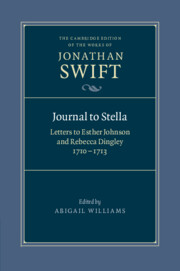Book contents
- Frontmatter
- Contents
- List of Illustrations Page
- General Editors’ Preface
- Acknowledgements
- Chronology
- List of Abbreviations
- Introduction
- Calendar of Letters
- Letters to Esther Johnson and Rebecca Dingley, 1710–1713
- Appendices
- A Swift, Harley, St John and the Political Debates Behind the Journal to Stella
- B Surviving Letters to and From Esther Johnson and Rebecca Dingley
- C Letter 2 in Print and Manuscript
- D Facsimile of Letter From Esther Johnson and Rebecca Dingley to Robert Dingley
- E Glossary of Little Language Used in the Journal to Stella
- F Biographical Appendix
- Textual Account
- Bibliography
- Index
E - Glossary of Little Language Used in the Journal to Stella
Published online by Cambridge University Press: 02 September 2021
- Frontmatter
- Contents
- List of Illustrations Page
- General Editors’ Preface
- Acknowledgements
- Chronology
- List of Abbreviations
- Introduction
- Calendar of Letters
- Letters to Esther Johnson and Rebecca Dingley, 1710–1713
- Appendices
- A Swift, Harley, St John and the Political Debates Behind the Journal to Stella
- B Surviving Letters to and From Esther Johnson and Rebecca Dingley
- C Letter 2 in Print and Manuscript
- D Facsimile of Letter From Esther Johnson and Rebecca Dingley to Robert Dingley
- E Glossary of Little Language Used in the Journal to Stella
- F Biographical Appendix
- Textual Account
- Bibliography
- Index
Summary
The little language works on the basis of mutation by substitution, most common of which is ‘l’ for ‘r’, and vice versa. We also find ‘t’ for ‘k/ck/ch/c’, ‘d’ for ‘th’, ‘h’ for ‘w’, ‘z’ for ‘th’ or ‘j’, ‘t’ for ‘th’, and ‘d’ for ‘g’. Some of the substitutions are purely graphic, and effectively identify the little language for the eye, without making any difference to the sound of the word: so, for instance, Swift writes ‘rite’ for ‘write’, or ‘nite’ for ‘night’. The most frequent distortion in the little language is the regular substitution of some consonantal sounds for others, such as ‘sick’ to ‘kick’, and also a reversal of sounds, such as ‘pocket’ to ‘pottick’, or ‘rold’ for ‘lord’. Translations to individual phrases or words are given in the annotations where necessary. The following list is a guide to some of the most common words, and is of necessity partly speculative.
aden again
bose both
cake cale take care
dallars girls
DD dear Dingley (?)
dee dear
dood good
drad glad
ee you
fais faith
flodive forgive
flom from
FW farewell
gangridge language
givar devil
hat what
hen when
high why
iss if
lele dear
maram madam
MD my dears
mollow morrow
muddle mother
nuntyes nine monkies mine
oo you
oomen women
oor your
paadon pardon
pdfr podefar, or ‘poor dear fellow’
plitty pretty
poodeerichar poor dear little
ppt poppet (?)
radyes ladies
rettle letter
richar little
rife life
rove love
sause because
seep sleep
sollahs sirrahs
tum ole come over
ung young
vely kick very sick
zat that
zees these
zinkerman gentleman
zis this
- Type
- Chapter
- Information
- Journal to StellaLetters to Esther Johnson and Rebecca Dingley, 1710–1713, pp. 576 - 577Publisher: Cambridge University PressPrint publication year: 2013

